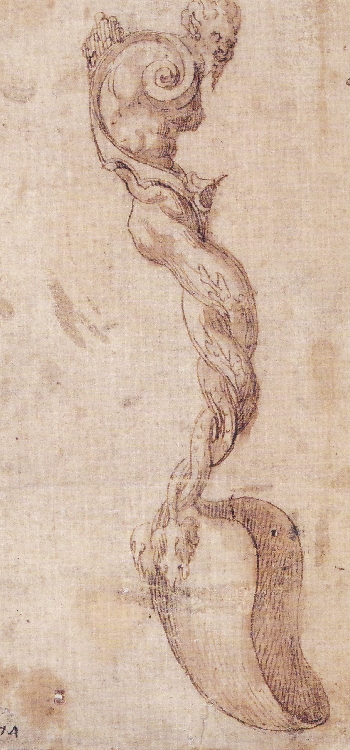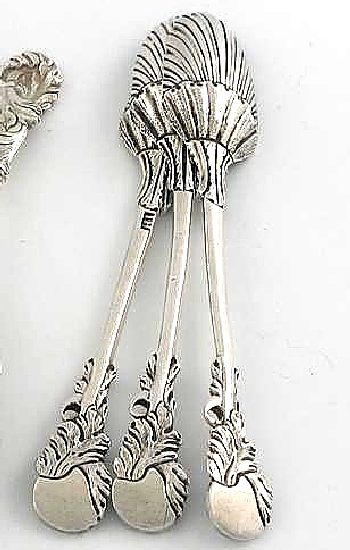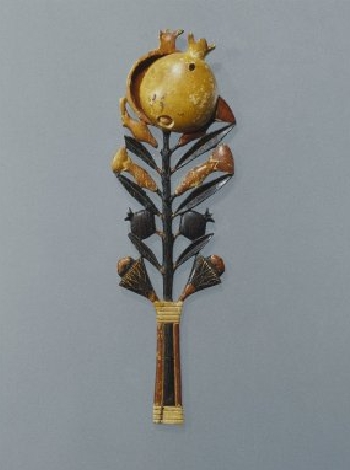Origin of Naturaistic Spoon
16th century vine patten spoon
 Design for Serving spoon, Italy, circa late 16th century.It is surprising that the most eraborate vine pattern spoon was already designed and created in late 16th century in Italy ! This drawing of the design for a serving spoon shows the ornate stem formed by vine tendrils dynamically interwining each other and the Bacchus sitting on the top. The deep bowl of the spoon is entwined with vine leaves.
Design for Serving spoon, Italy, circa late 16th century.It is surprising that the most eraborate vine pattern spoon was already designed and created in late 16th century in Italy ! This drawing of the design for a serving spoon shows the ornate stem formed by vine tendrils dynamically interwining each other and the Bacchus sitting on the top. The deep bowl of the spoon is entwined with vine leaves.
It seems that this design is more artistic and powerful than the most ornate pierced vine pattern in 19th century. Certainly it bears rather mythological realism than modern naturalism.
This drawing is put on 12 page of the book "FEEDING Desire, Design and the Tools of the Table 1500-2005, Cooper-Hewitt National Design Museum".
Leaves stem and dove finial pattern since 16th century
 Leaf stem spoon, circa 1680. Length 15.6 cm, Weight 42 gramsThe stem with stem wreathed with vine leaves, and with dove finial, the back of the bowl engraved in the style of c. 1680 with acanthus leaves.
Leaf stem spoon, circa 1680. Length 15.6 cm, Weight 42 gramsThe stem with stem wreathed with vine leaves, and with dove finial, the back of the bowl engraved in the style of c. 1680 with acanthus leaves.
Spoons of similar pattern are mentioned in the inventory of Henry VIII (1491-1547)'s plate, but this is claerly later one.
This picture is put on 123 page of the book "EUROPEAN SPOONS BEFORE 1700", John Emery.
Rococo Grand Pattern by Jean Harrache circa 1730
 A set of nine teaspoons with shell bowls and scrolling leaf terminals (Rococo Grande pattern), 6 of them are crested and bear the Francis Harrache's mark and 1 of them bears the Jean II Harrache's mark 'IH' and the other 2 are unmarked.A set of nine teaspoons with shell bowls and scrolling leaf terminals, 6 of them are crested and bear the Francis Harrache's mark and 1 of them bears the Jean II Harrache's mark 'I・H' in rectangular and the other 2 are unmarked.
A set of nine teaspoons with shell bowls and scrolling leaf terminals (Rococo Grande pattern), 6 of them are crested and bear the Francis Harrache's mark and 1 of them bears the Jean II Harrache's mark 'IH' and the other 2 are unmarked.A set of nine teaspoons with shell bowls and scrolling leaf terminals, 6 of them are crested and bear the Francis Harrache's mark and 1 of them bears the Jean II Harrache's mark 'I・H' in rectangular and the other 2 are unmarked.
This design is rather rough and blunt than the other spoons in Rococo Grand pattern made by Francis Harrache. In the other words, it could be relatively early example.
The maker's mark "IH" could be that of Jean II Harrache (1698-?) who is 12 years older than Francis Harrache (1710-1757), and 2 years older than John I Derussat (1700?-1758).
Michael Snodin described in his book that "These Precise dating is difficult as they are often unmarked or bear only an identified maker's mark, but the type is generally believed to have begun by the early 1740s, and had probably ceased being made by 1770."
Given the facts that the tea equipage by Paul de Lamerie bear the hallmark of 1735/6 and the whip pattern of the spoons seems to be the pre-stage of the Rococo Grand pattern, the Rococo Grand pattern seems to start mid 1730s.
Seiji Yamauchi, April 2010
Ointment-Spoon, Egypt, late 18th Dynasty (B.C.1336-B.C.1327)
 Ointment-Spoon, ca. 1336-1327 B.C.E. Ivory, 6.5 x 1.8 x 20.8 cm. Brooklyn MuseumThis is a 3000 years old Naturalistic oinyment-spoon imitating pomegranates.
Ointment-Spoon, ca. 1336-1327 B.C.E. Ivory, 6.5 x 1.8 x 20.8 cm. Brooklyn MuseumThis is a 3000 years old Naturalistic oinyment-spoon imitating pomegranates.
The pomegranate is native to the region of Persia and the Himalayan ranges of India, and has been cultivated in Iran, Afghanistan, Pakistan, North India, Armenia, Azerbaijan, Georgia, and the Mediterranean region for several millennia. The name pomegranate derives from Latin pomum (apple) and granatus (seeded).
In the Indian subcontinent's ancient Ayurveda system of medicine, the pomegranate has extensively been used as a source of traditional remedies for thousands of years. Ayurveda differentiates between pomegranate varieties and employs them for different remedies.
The rind of the fruit and the bark of the pomegranate tree is used as a traditional remedy against diarrhea, dysentery and intestinal parasites. The seeds and juice are considered a tonic for the heart and throat, and classified as a bitter-astringent (pitta or fire) component under the Ayurvedic system, and considered a healthful counterbalance to a diet high in sweet-fatty (kapha or earth) components. The astringent qualities of the flower juice, rind and tree bark are considered valuable for a variety of purposes, such as stopping nose bleeds and gum bleeds, toning skin, (after blending with mustard oil) firming-up sagging breasts and treating hemorrhoids. Pomegranate juice (of specific fruit strains) is also used as eyedrops as it is believed to slow the development of cataracts.
Its story is something of a mystery, said the traveller Pausanias in the 2nd century.
The myth of Persephone, the chthonic goddess of the Underworld, also prominently features the pomegranate.
In the 6th century BC, Polykleitos took ivory and gold to sculpt the seated Argive Hera in her temple. She held a scepter in one hand and offered a pomegranate, like a 'royal orb', in the other. Indeed, in the Orion story we hear that Hera cast pomegranate-Side (an ancient city in Antalya) into dim Erebus — "for daring to rival Hera's beauty", which forms the probable point of connection with the older Osiris/Isis story.
Since the ancient Egyptians identified the Orion constellation in the sky as Sah the "soul of Osiris", the identification of this section of the myth seems relatively complete. Hera wears, not a wreath nor a tiara nor a diadem, but clearly the calyx of the pomegranate that has become her serrated crown. The pomegranate has a calyx shaped like a crown.
In Jewish tradition it has been seen as the original "design" for the proper crown. In some artistic depictions, the pomegranate is found in the hand of Mary, mother of Jesus.
The late Eighteenth Dynasty was one of the the most flamboyant and excessive periods of design in Egyptian history. This spoon demonstrates the dominant aesthetic of the day: the complementary union of naturalistic elements, formal design, and excessive, stylized detailing.
The motif is a pomegranate branch terminating in a huge reddish-yellow fruit that swivels on a tiny pivot to reveal the bowl of the spoon. Tiny pomegranates, brightly painted flowers, and slender leaves project from the stem that serves as the handle. Beneath the lowest leaves the artisan has added an extraordinary embellishment: two lotus flowers, each with a Mimispos fruit emerging from it.
Although the individual elements of the spoon are treated with painstaking attention to detail, the design itself is pure fantasy. For example, pomegranate flowers and fruit never appear on a tree at the same time.
Medium: Ivory
Place Made: Egypt
Dates: ca. 1336-1327 B.C.E.
Dynasty: late XVIII Dynasty
Period: New Kingdom
Dimensions: 6.5 x 1.8 x 20.8 cm
Museum Location: In Brooklin Museum, this item is on view in Egypt Reborn: Art for Eternity, 19th Dynasty to Roman Period, Martha A. and Robert S. Rubin Gallery, 3rd Floor
Brooklin Museum and Wikipedia
 Top
Top Site Map
Site Map References
References About Me
About Me